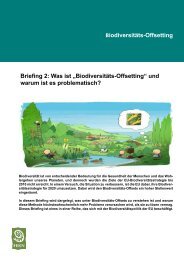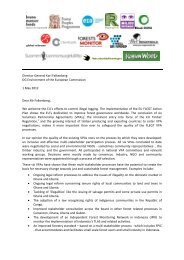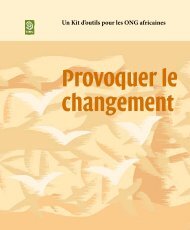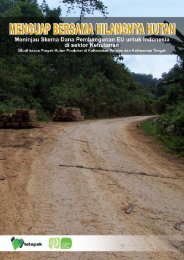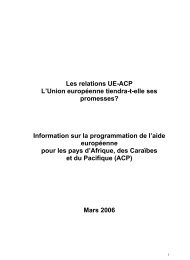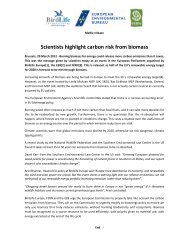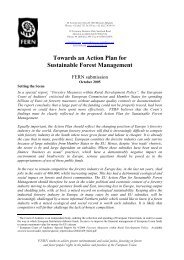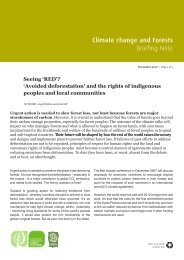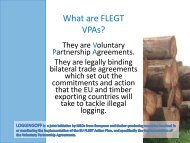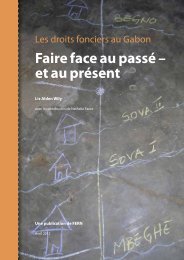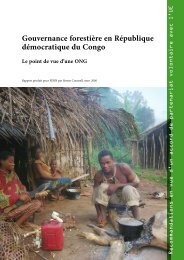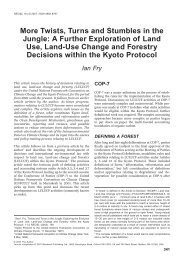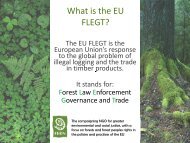Papua New Guinea - Fern
Papua New Guinea - Fern
Papua New Guinea - Fern
Create successful ePaper yourself
Turn your PDF publications into a flip-book with our unique Google optimized e-Paper software.
maintain, accelerate and subsidize commercial scale logging of primary rainforests.<br />
Protected Areas, and Biodiversity Conservation<br />
The customary land tenure system whereby PNG’s tribal clans control their land communally<br />
presents tremendous opportunities to develop culturally appropriate conservation models.<br />
Landowners maintain final control over the use of the land. Clearly the Western national park<br />
model does not work under such a circumstance. If decisions by clans to pursue conservation<br />
were granted the same legitimacy as other land use decisions – such as logging or oil palm<br />
production – there would be the opportunity to construct extensive protected areas on the basis of<br />
many individual clan based conservation agreements.<br />
There has been a remarkable lack of imagination shown regarding how to use customary land<br />
tenure for the benefit of biodiversity conservation. The World Bank views the land system as an<br />
obstacle to economic development, and thus fails to support dynamic and innovative local<br />
initiatives to implement culturally appropriate protected areas. There are means to establish<br />
protected areas under PNG law. However, one type focuses primarily on wildlife and does not<br />
make provision for land-use planning and management guidelines; while the other provides more<br />
meaningful protections but is so difficult to implement that it has never been pursued. This<br />
global biodiversity treasure trove is in risk of having grossly inadequate strictly protected areas.<br />
There have been two major efforts to identify areas of relatively high biodiversity importance –<br />
the Conservation Needs Assessment and the BIORAP mapping exercise. Both were done mostly<br />
by international consultants and have not resulted in building lasting mapping and planning<br />
expertise in PNG. Once an area is identified as a priority in terms of biodiversity, there is no<br />
system in place to remove these areas from the pool of forests likely to be industrially harvested.<br />
The requirement that logging areas include conservation set asides is widely flaunted and usually<br />
targets lands that lack forest resources which are commercially viable. Even if done properly,<br />
these areas would not be large enough to maintain the full range of biodiversity and ecosystem<br />
values found in the now intact and contiguous rainforests.<br />
Indigenous Peoples’ Rights/ Customary Use and Local Support<br />
As noted previously, PNG’s forest owners have not been engaged in biodiversity planning to any<br />
meaningful extent. Rarely do international conservation planners set forth out of the capital,<br />
only occasionally making it to a provincial center, and rarely to a village or actual rainforest.<br />
Strengthening indigenous and local community’s participation in the National Biodiversity<br />
Strategy and Action Plan would require taking these proceedings out to remote villages where<br />
<strong>Papua</strong> <strong>New</strong> <strong>Guinea</strong>ns live. Those managing the World Bank’s program on the biodiversity<br />
enabling activities have little in-country experience and have little understanding of the needs,<br />
aspirations and feelings regarding biodiversity of PNG’s indigenous peoples. This dangerous<br />
lack of knowledge of the country by those facilitating implementation of the CBD virtually<br />
guarantees that another document is written that is removed from reality, rarely read, and does<br />
little to conserve biodiversity.<br />
The tremendous non-market benefits of forests to PNG citizens are not appreciated. The poverty<br />
associated with dispossessed ecological refugees – as occurs elsewhere - is confused with frugal,<br />
subsistence living of PNG’s citizens which, while materially lacking, meets most needs for food,<br />
9



